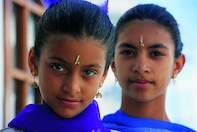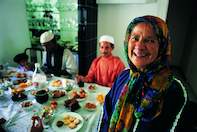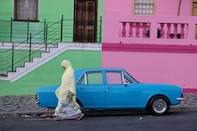Malay Families
On a certain day in the Bo-Kaap (Upper Cape), there is unusual activity in the houses of Malay families as little girls ranging anything from three to twelve years old are dressed up in colourful silken flower dresses handed down by older sisters and cousins. The little girls are then made up.

Lipstick is applied and kohol, the traditional eyeliner was worn, ironically, mostly by men in the desert. The reason for this is that the dark coal-like substance absorbs heat and tends to cool the eyelids of the nomads who range from the desert. Finally, resplendent in their silk dresses, processions of young girls and women make their way towards the mosque.
They have with them boards and knives handed down from generation to generation. These will be used to slice the orange leaves. In the Bo-Kaap this is known as Rampies-sny, literally, to 'cut the mixture'. Soon the air becomes redolent with the smell of orange. The occasion is the Feast of the Orange Leaves, chosen to celebrate the birthday of the Prophet.
The sliced leaves are flavoured with expensive oils, mainly rose oil. They are then put into sachets, each one adorned with a red rose and left in the mosque. Then the day pauses and it is silent once again. But at dusk, the adult men begin to make their way to the mosque.
After prayers, they return home with their gifts and in the dimly lit streets, their sonorous voices can be heard calling out, their white flowing robes gleaming in the street lights as they trundle across cobble-stone streets. When the husband arrives home he makes a gift of the rose to his wife and he places the little aromatic sachet in his wardrobe.
This will smell of citrus fruit for the next year, perfuming his clothes until the next Feast of the Orange Leaves. I remember being fascinated by this. But there was another emotion too, that of envy. I was jealous of a people able to create a sense of mystery, a ritual of beauty, right here in the city where I lived.
It was so far removed from the usual 'Western' pursuits, eight hours at work, an hour on the freeway, supper, television, and to bed. Even the possible pleasures, the movies and the clubs, seemed shallow in comparison. I remembered being invited into the home of a Malay family while taking photographs.
They offered me coffee and little cakes. The daughter entered, carrying the mother's baby. I wanted to photograph her but she was shy. I was also envious of a community that was able to trust strangers, that was able to show hospitality because it is in their nature.
But then, this is in the spirit of Kanalla, and it has existed for centuries. It is something I, growing up in the city, was only dimly aware of. The Spirit of Kanalla means that during hard times they stand together and help one another. And if the smells emanating from your dinner reach the house of your more needy neighbour, you will send across a plate of food from your table.
The first Malays arrived here three centuries ago. Most were brought from the Archipelago, comprising Sumatra, Java and Malaysia. But mostly they came from Java. The Dutch, who colonised the East, forbade them to practise Islam so this they had to do in secret.
This explains why the graves of their ancestors, Kramatte, are traditionally built high up on the mountain slopes. During the Dutch Colonial period, many of them lived and worshipped clandestinely. The most famous Malay to be banished to the Cape was the Sultan Sheik Yousef, said to be a brave warrior and a thorn in the flesh of the Dutch Colonial powers.
Being a person of considerable piety and intelligence he enjoyed a tremendous following in his native country. The Dutch, fearing his execution might precipitate a popular uprising, decided to banish him to the Cape. It is told that here the Dutch Governor at the Cape, Simon van der Stel, befriended him and regarded the prince as his 'guest', rather than his prisoner.
They settled in the Bo-Kaap on the slopes of Signal Hill and this area constitutes the Malay Quarter. Their houses, which their ancestors built with their own hands, attest to the Malay skills as builders. They were also tailors and carpenters and during the early years, many were employed as coopers in the Cape wine industry.
Their skills and crafts were handed down through the generations. To this day, if you need to have a suit altered, or a dress, you invariably go to a Malay tailor who still plies his trade in his home. But this trade is a dying one, and the tailor you'll find is likely to be old, with arthritic hands, bent over his antiquated Singer sewing machine.
But the chances are you will think of him as wise, as wisdom often translates as tranquillity. His sons, instead of learning the art of tailoring, will have gone to university to study computer science or medicine or law. Centuries ago the Malay women brought with them their culinary skills, their almost serene knowledge of cumin, mustard seed and masala.
Cape Malay Traditions

Even today, crossing a square, you will be surprised by the delightful smell of Malay curry wafting towards you. And so, in a tactile way, you are reminded of their presence. Traditions are strong, and the Malays live strictly according to the dictates of the Koran.
A young boy starts to learn the Koran from an early age and before he is ritualistically accepted as a man, which is the equivalent of our confirmation, he must have a thorough knowledge of the Koran and be able to recite from it. Moreover, he must be able to enunciate correctly, giving subtle emphasis where required.
Marrying is usually arranged between families and permission is given by the prospective father-in-law, with the consent of the young bride. The Maskawi (money paid to the bride) decided on may vary from a few rands to a house or more, depending on the wealth of the bridegroom. A few days before the wedding the bride and her bridesmaids, in wedding array, call on her friends to invite them to the feast.
On the wedding day, the bride wears a headdress that reminded the poet I.D. du Plessis of the golden ballets of Bali - the medora - and a veil. She receives guests in her first wedding dress while the bridegroom attends the ceremony at the mosque. She is represented there by her father.
In the old days, she would be fetched by a coach drawn by four white horses plumed with ostrich feathers, driven by a coachman wearing the traditional toering (tudong: Malay for conical straw hat). Several changes of dress would follow. Should she belong to a wealthy family, a third and even a fourth dress might be worn.
In his book on the Cape Malay, du Plessis described how another carriage would follow behind her 'containing four bridesmaids in sea-green, with tall, pointed headdresses spiked out with gold from which floated embroidered veils of green'. Today, of course, people travel in cars and, sadly, the brilliant spectacle of plumed horses can no longer be seen.
But the bride is still resplendent in silk and she still wears a gilded headdress, which is typically Malay, and she will change her gown at least once. The most significant date on the Islamic calendar is, of course, Ramadan, during which the Malay fast for a period of a month.
When the new moon is sighted the Malay get together to prepare their feasts. Once again the Spirit of Kanalla prevails and the poor, who perhaps cannot afford it, are given meat by the more affluent. During the fast of Ramadan, an important event occurs for which the Malay traditionally prepare by cleaning their houses.
This is the Holy Night, in which forgiveness of sins is granted to the faithful. During this night, the angels and souls of Heaven descend to earth and many miracles are performed. Their religion is a practical one, a way of life and, although they are a peace-loving community, if their way of life is threatened, the threat will be met with stern resistance.
The Legacy of Bo-Kaap

When I visited Zany, the effervescent owner (her name suits her) of the Bo-Kaap Bazaar, she offered me little cakes and told me they were twee-gevriets (two-faced). True enough, each side had a different face in icing. I asked her what this meant, and she told me that during the early years of Apartheid, 50 or so years ago, General Hertzog promised the Malays a better deal.
He never honoured his promise. Today the memory of this statesman is celebrated somewhat ambiguously in this culinary fashion. Zany's sister, Shereen, has a thorough knowledge of the history of the Bo-Kaap and takes groups on daily tours around the region. On your tour, you may find yourself surprised by the number of pigeons.
This a legacy of the past, when council regulations forbade Malays to keep pets (because of the closeness of the houses). But keeping pigeons was allowed, so many of the houses have pigeon lofts. Noticing a large number of pigeons being fed by an old man, I asked Zany about this and she told me the story about the pigeons.
If I was charmed at first, I was dismayed when, later on, she added that as children they made pigeon pie when the birds became too plentiful. I looked at her, shocked by this disclosure, and she gazed back at me peacefully, in typically Malayan fashion. And behind that 'timeless gaze' I thought I discerned the faintest trace of humour.
By Johan Liebenberg